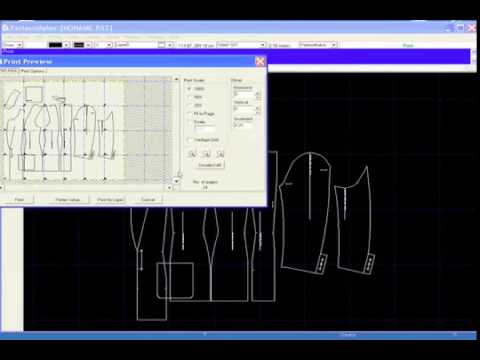Patternmaker Job Description and Salary: Find out the details of this creative and well-paying profession!
Patternmaker Job Description and Salary
A Patternmaker is a skilled professional who plays a crucial role in the apparel industry. They are responsible for creating patterns and templates that serve as guides for cutting and assembling fabrics to create garments.
Patternmakers work closely with fashion designers and garment manufacturers to understand their vision and translate it into precise patterns. They use specialized computer software or create patterns manually to ensure accurate measurements and fit. Additionally, they may also make adjustments to patterns based on feedback from sample fittings and collaborate with other team members to resolve any design or construction issues.
As for the salary of a Patternmaker, it can vary depending on factors such as experience, location, and employer. On average, a Patternmaker can earn between $40,000 and $70,000 per year. However, highly skilled and experienced Patternmakers working for renowned fashion houses or companies may earn significantly higher salaries.
In conclusion, being a Patternmaker requires technical expertise, attention to detail, and creativity. It is a rewarding career choice for individuals passionate about fashion and keen on contributing to the creation of high-quality garments.

Patternmaker Job Description Template
Patternmaker Job Description A patternmaker is a highly skilled professional who works in the fashion industry. They are responsible for creating patterns for clothing, accessories, and other textile products. Patternmakers use their expertise in design, mathematics, and garment construction to develop precise templates for production. Key Responsibilities: – Collaborating with fashion designers to understand their vision and translate it into a pattern. – Analyzing sketches, measurements, and specifications to determine the appropriate pattern. – Utilizing computer-aided design (CAD) software to create digital patterns. – Developing prototypes and samples to test the accuracy and fit of the patterns. – Making adjustments and modifications to the patterns based on feedback from designers and fit models. – Ensuring that the patterns are scalable and can be easily reproduced in different sizes. – Communicating with production teams to provide detailed instructions on pattern construction. – Staying updated with industry trends and techniques to enhance patternmaking skills. – Conducting quality control checks to ensure that the final product meets the desired standards. Key Skills: – Precision: Patternmakers must have exceptional attention to detail and accuracy in creating patterns to guarantee proper fit and proportions. – Creativity: They should possess a strong sense of creativity to interpret design concepts and translate them into functional patterns. – Technical proficiency in computer-aided design (CAD) software is essential for creating digital patterns efficiently. – Strong knowledge of garment construction, fabric properties, and sewing techniques. – Excellent problem-solving and analytical skills to troubleshoot pattern issues and make necessary adjustments. – Effective communication and collaboration abilities to work closely with designers, fit models, and production teams. In summary, a patternmaker plays a crucial role in the fashion industry by creating patterns that serve as the foundation for garment production. Their precision, creativity, and technical skills are vital in ensuring that the final product meets the desired standards of fit and design.Patternmaker Responsibilities
Patternmaker Requirements
How Much Does A Patternmaker Make?
Patternmaker Salary
| Experience Level | Average Salary |
|---|---|
| Entry Level | $35,000 – $40,000 |
| Intermediate Level | $40,000 – $55,000 |
| Experienced Level | $55,000 – $70,000 |
| Senior Level | $70,000 and above |
A Patternmaker is responsible for creating patterns for garments, shoes, accessories, and other textile products. They work closely with designers and manufacturers to ensure accurate and precise patterns are created for production. The salary of a Patternmaker varies based on their experience level. Entry-level Patternmakers can expect to earn an average salary of $35,000 to $40,000 per year. As they gain more experience and expertise, their salary can increase to $40,000 to $55,000 for intermediate-level positions. Experienced Patternmakers with a proven track record can earn between $55,000 to $70,000 annually. Senior-level Patternmakers, with extensive experience and leadership skills, can earn $70,000 and above per year. It’s important to note that these salary ranges can vary based on factors such as location, company size, and industry demand.
Patternmaker Salaries by Country
Top Paying Countries for Patternmaker
| Country | Average Salary (USD) |
|---|---|
| Switzerland | $72,000 |
| United States | $60,000 |
| Australia | $55,000 |
| Canada | $52,000 |
| Germany | $48,000 |
A patternmaker is responsible for creating templates or patterns used in the manufacturing of various products. The salary of a patternmaker can vary depending on the country. According to the data, Switzerland is the top paying country for patternmakers, with an average salary of $72,000. The United States follows with an average salary of $60,000, while Australia, Canada, and Germany also offer competitive salaries in the range of $48,000 to $55,000. These salaries reflect the demand for skilled patternmakers and the cost of living in each respective country.
A video on the topic Patternmaker
Video Source : PatternMaker SoftwareInterview Questions for Patternmaker
1. What is a patternmaker?
A patternmaker is a professional who creates patterns for various garments and accessories. They use their knowledge of sewing and garment construction to develop templates that are used to cut and sew fabric pieces together.
2. What skills are required to be a successful patternmaker?
Successful patternmakers should have a strong understanding of garment construction, excellent mathematical and measurement skills, proficiency in using patternmaking software, and the ability to translate design sketches into accurate patterns.
3. What tools and equipment are commonly used by patternmakers?
Patternmakers commonly use tools such as rulers, measuring tapes, French curves, pattern drafting paper, scissors, pins, and pattern notcher. In addition, they may also use computer-aided design (CAD) software for creating digital patterns.
4. What is the importance of accurate patternmaking in the garment industry?
Accurate patternmaking is crucial in the garment industry as it ensures that garments fit well and are aesthetically pleasing. It also helps in minimizing fabric wastage and improving the efficiency of the production process.
5. How do patternmakers collaborate with designers and garment manufacturers?
Patternmakers collaborate with designers by interpreting their design sketches and creating pattern prototypes that match the desired style and fit. They also work closely with garment manufacturers to ensure that patterns are accurately translated into finished garments during the production process.
6. Can you explain the process of patternmaking?
The process of patternmaking involves taking design sketches or specifications and creating a template that represents each fabric piece of the garment. This template is then used to cut the fabric and sew the pieces together to create the final garment.
7. What are the different types of patternmaking techniques?
There are various patternmaking techniques, including flat patternmaking, draping, and computer-aided design. Flat patternmaking involves creating patterns on a flat surface, while draping involves manipulating fabric directly on a dress form. Computer-aided design uses software to create digital patterns.
8. How do patternmakers ensure the accuracy of their patterns?
Patternmakers ensure accuracy by taking precise measurements, using mathematical calculations, and making multiple fittings and adjustments. They also rely on their knowledge of garment construction and fit to create patterns that will result in well-fitting garments.
9. What challenges do patternmakers commonly face?
Patternmakers may face challenges such as translating complex design sketches into patterns, ensuring proper fit for different body types, and adapting patterns for mass production. They may also encounter challenges related to fabric behavior and the need for continuous learning to keep up with fashion trends and technology advancements.
10. What are some career opportunities for patternmakers?
Patternmakers can find employment in various sectors of the fashion industry, including clothing manufacturing companies, design studios, fashion brands, and patternmaking service providers. They may also choose to work as freelancers or start their own patternmaking businesses.






